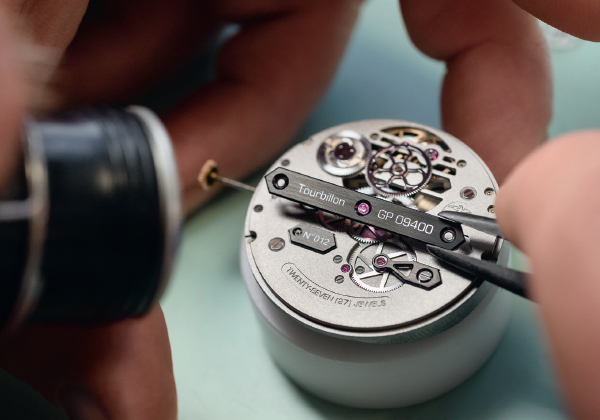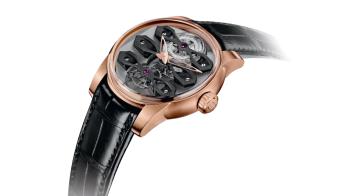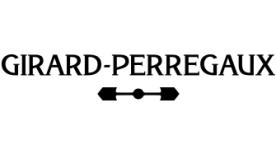In 2014, Girard-Perregaux released its first Neo-Tourbillon with Three Bridges. The piece was the brainchild of Stefano Macaluso. Like his father Gino, the former chairman and owner of the brand, he had trained as an architect at the University of Turin. This gave him a keen sense of construction, volumes, and empty space – a fundamental aspect of any building. The main distinctive feature of the watch is its movement. Lacking any form of a dial, the calibre takes up the entire view. The case itself is very simple (round, with cambered sides and short lugs), and most of its thickness is accounted for by one of the first ‘glass-box’ sapphire crystals in modern history, so the structure of the GP09400 calibre is essentially the whole story when it comes to this watch.
In the beginning...
The whole story? Not quite, as the Neo is in fact an updated, modernised, quasi-futuristic version of one of watchmaking’s greatest classics. In 1991, Girard-Perregaux adapted an exquisitely beautiful pocket watch movement dating back to around 1860, turning it into a wristwatch whilst preserving its distinctive features, namely its tourbillon regulator and its structure. The Tourbillon with Three Gold Bridges features a linear gear train spanned by three broad bridges: one for the barrel, one for the centre wheel, and one for the tourbillon cage. All three are solid gold, and in the absence of any dial, they are clearly visible beneath the crystal. Back in 1991, barely ten brands were producing tourbillons. They had few takers, and no firm had ventured into this kind of showcasing before. The GP9900S calibre is full of sophisticated watchmaking details, too. The level of the finishes is outstanding, in particular the work on the bridges – the stars of the structure. Their angling, polishing, and shaping has kept whole cohorts of watchmakers busy in the workshops on Place Girardet, La Chaux-de-Fonds.

Founder
Spawning a range of different styles, with the addition of an automatic micro-rotor winding mechanism (still very rare, and a pioneering move), and incorporating many different complications, the Three Bridges was one of the most important movements of its generation, definitely one of the most beautiful, and clearly a rich source of inspiration. It was a forerunner; a kind of original matrix that has influenced many other timepieces. Its mechanistic style, giving the movement pride of place, was more than 15 years ahead of its time. Not to mention the many vocations it encouraged – watchmakers who quote it as a key influence during their formative years.
Version 2.0
The Neo-Tourbillon with Three Bridges is proof that an old concept can be brought firmly into the present day by dint of good design. The watchmaking structure itself has been preserved. As in version 1.0, the structure is in fact a reversed one. Everything usually to be found at the rear has been brought forward onto the dial, directly beneath the hands. The bridges are perhaps even more dominant than before. The solid white gold micro-rotor provides a 72-hour power reserve, which is huge, especially given that there’s a tourbillon to be powered, even if it is such a light one (0.25g, thanks to the cage being titanium). Furthermore, the winding mechanism is completely hidden from view beneath the barrel.

Enchancing the bridges
The essential transformation is an aesthetic one, but no less significant because of that. In this context, it’s a watchmaking fundamental. It applies first and foremost to the bridges, the central characters in this story: they now extend into the third dimension. Arched, shaped, and skeletonised, their complex openwork further increases the incredible sense of tension in their lines. This has created an open space in the centre of the watch beneath the bridges, a valley simply begging to be spanned three times by an architect, and complete with its own river: the gear train. To achieve this vast expanse, all the organs, wheels, levers, springs and other parts have been hidden in the intermediate layers of the calibre, or moved to the rear. As a result, the very flat, sparse background does not draw the gaze as it might with other similar calibres. The colours range from pale grey to near-black. Their matt, sandy, almost rough textures result in a mineral grain similar to concrete. Perhaps what we’re really looking at here is a scale model of a mind-bending architectural project, disguised as a wristwatch.
*This year GMT Magazine and WorldTempus have embarked on the ambitious project of summarising the last 20 years of the Tourbillon in The Millennium Watch Book - Tourbillons, a big, beautifully laid out coffee table book. This article is an extract. The Millennium Watch Book - Tourbillons is available on www.the-watch-book.com, in French and English.





